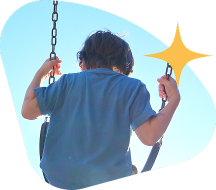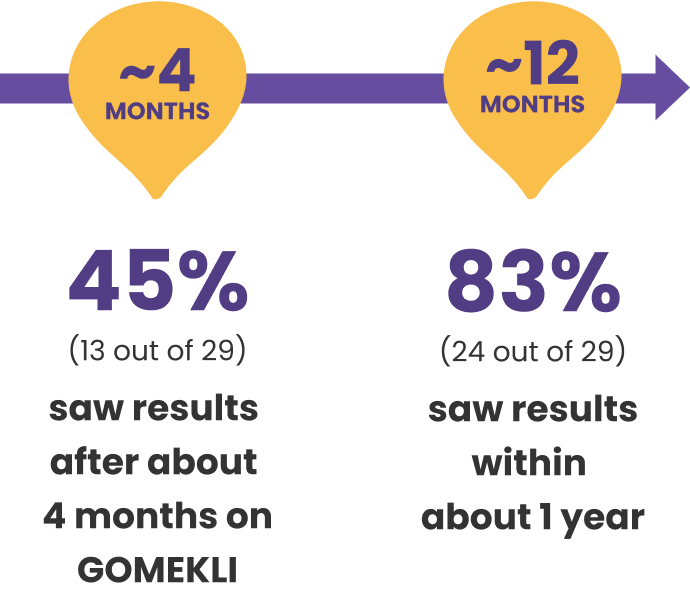GOMEKLI is proven to help kids with NF1-PN
Actor portrayal.
What is GOMEKLI (mirdametinib)?
GOMEKLI is a prescription medicine used to treat adults and children 2 years of age and older with neurofibromatosis type 1 (NF1) who have plexiform neurofibromas (PN) that cause symptoms and cannot be completely removed by surgery.
It is not known if GOMEKLI is safe and effective in children younger than 2 years of age.
GOMEKLI is a MEK inhibitor, which is targeted therapy – not traditional chemotherapy. It works by helping to block certain signals in the body that cause plexiform neurofibromas to grow.

GOMEKLI has been proven to shrink plexiforms in children and adolescents (age 2-17) with NF1-PN
GOMEKLI was studied in one of the largest (N=114) clinical trials for neurofibromatosis type 1 with plexiform neurofibromas (NF1-PN).
52% of children/adolescents
(29 out of 56) treated with GOMEKLI
SAW THEIR PLEXIFORM SHRINK by at least 20%*
15 of these children/adolescents
SAW THEIR PLEXIFORM SHRINK
Plexiform before starting GOMEKLI
20%
SMALLER
50%
SMALLER
*Reduction in plexiform size had to be confirmed on a later magnetic resonance imaging (MRI) scan.
†The 50% reduction in plexiform size was an exploratory analysis, meaning it was not specifically defined in advance of the trial.
Plexiform is short for plexiform neurofibroma, which can also be called a PN.
Why 20%?
– Julie, GOMEKLI Caregiver Ambassador
In children/adolescents who benefited from treatment, plexiforms started to shrink within months of taking GOMEKLI


In children/adolescents who benefited from treatment, plexiforms began to shrink by at least 20% within 4 and 19 months of starting GOMEKLI. The median (middle) amount of time it took for plexiforms to begin shrinking was 7.9 months.
85% of children/adolescents chose to keep taking GOMEKLI in an optional long-term follow-up phase of the study.
Possible side effects with GOMEKLI (mirdametinib)
- Diarrhea
- Muscle, joint, and bone pain
- Stomach (abdominal) pain
- Vomiting
- Headache
- Nausea
- Skin redness, swelling, or pain around the fingernails or toenails
Most children/adolescents taking GOMEKLI did not have to stop treatment due to a side effect
had to stop treatment due to a side effect
Your healthcare provider may interrupt, reduce, or permanently stop GOMEKLI treatment if you experience certain side effects.
GOMEKLI may also cause serious side effects, including:
Eye problems
Tell your healthcare provider right away if you get any of the following signs or symptoms of eye problems:
- Blurred vision, loss of vision, or other changes to your vision
Heart problems
Tell your healthcare provider right away if you get any of the following signs or symptoms of heart problems:
- Coughing or wheezing, shortness of breath, swelling of your ankles and feet, tiredness, increased heart rate
Skin problems
Tell your healthcare provider if you develop any of the following signs or symptoms of skin problems:
- Flat skin rash, raised bumps on the skin, skin bumps that look like acne, skin redness, itchy rash, peeling skin
During Jacoby’s treatment, he experienced headaches and nausea. To get ahead of this, we gave him an over-the-counter pain reliever 1 to 2 days before his treatment-free week, which helped him manage the side effects he was experiencing.
– Julie, GOMEKLI Caregiver Ambassador
Find the care you need
Use the doctor finder tool to locate a healthcare provider who has experience with NF1 near you.
Is GOMEKLI right for me?
This guide can help you and your healthcare provider understand if GOMEKLI could be right for you.
Dosing that fits your needs
Available in capsules or tablets for oral suspension that give you the option to take GOMEKLI as a liquid.
What is GOMEKLI?
GOMEKLI (mirdametinib) is a prescription medicine used to treat adults and children 2 years of age and older with neurofibromatosis type 1 (NF1) who have plexiform neurofibromas that cause symptoms and cannot be completely removed by surgery.
It is not known if GOMEKLI is safe and effective in children under 2 years of age.
Important Safety Information
Before taking GOMEKLI, tell your healthcare provider about all of your medical conditions, including if you:
- Have eye problems
- Have heart problems
- Are pregnant or plan to become pregnant. GOMEKLI can harm your unborn baby
Females who are able to become pregnant:
- Your healthcare provider should check to see if you are pregnant before you begin treatment with GOMEKLI.
- Use effective birth control (contraception) during treatment with GOMEKLI and for 6 weeks after your last dose.
- Tell your healthcare provider right away if you become pregnant or think you may be pregnant during treatment with GOMEKLI.
Males with female partners who are able to become pregnant:
- Use effective birth control (contraception) during treatment with GOMEKLI and for 3 months after your last dose.
- Tell your healthcare provider right away if your female partner becomes pregnant or thinks she may be pregnant during treatment with GOMEKLI.
- Are breastfeeding or plan to breastfeed. It is not known if GOMEKLI passes into your breast milk.
- Do not breastfeed during treatment with GOMEKLI and for 1 week after your last dose.
- Talk to your healthcare provider about the best way to feed your baby during this time.
Tell your healthcare provider about all the medicines you take, including prescription and over-the-counter medicines, vitamins, and herbal supplements.
How should I take GOMEKLI?
- Take GOMEKLI exactly as your healthcare provider tells you to take it. Your healthcare provider may change your dose, temporarily stop, or permanently stop treatment with GOMEKLI if you develop certain side effects.
- Take GOMEKLI twice a day, about 12 hours apart, for 21 days, followed by 7 days off treatment, to complete a 28-day treatment cycle. Your healthcare provider will decide how many treatment cycles are right for you.
- Take GOMEKLI with or without food.
- GOMEKLI comes in two different dosage forms, GOMEKLI capsules and GOMEKLI tablets for oral suspension. Your healthcare provider will decide the dosage form and dose of GOMEKLI that is right for you.
- If you take GOMEKLI capsules: Swallow each capsule whole with drinking water. If more than 1 capsule is required, swallow 1 capsule at a time. Do not open, break or chew the capsules.
- If you take GOMEKLI tablets for oral suspension, either:
- Swallow each tablet for oral suspension whole with drinking water. If more than 1 tablet is required, swallow 1 tablet at a time.
- Disperse the tablets for oral suspension in drinking water to make a liquid (suspension) before you take or give GOMEKLI.
OR
See the “Instructions for Use” that come with your medicine for instructions on how to prepare and take GOMEKLI tablets for oral suspension.
- If you miss a dose of GOMEKLI, skip the missed dose and take your next dose at your regularly scheduled time.
- If you vomit at any time after taking GOMEKLI, do not take an additional dose. Take your next dose at your regularly scheduled time.
What are the possible side effects of GOMEKLI?
- Eye problems. GOMEKLI may cause eye problems that can lead to blindness. Your healthcare provider will check your vision before and during treatment with GOMEKLI. Tell your healthcare provider right away if you get any of the following signs or symptoms of eye problems:
- Blurred vision
- Loss of vision
- Other changes to your vision
- Heart problems. GOMEKLI may lower the amount of blood pumped by your heart, which is common in children during treatment with GOMEKLI and can also be severe. Your healthcare provider will do tests before you start GOMEKLI treatment, every 3 months during your first year of treatment, and then as needed to make sure your heart is working properly. Tell your healthcare provider right away if you get any of the following signs or symptoms of heart problems:
- Coughing or wheezing
- Shortness of breath
- Swelling of your ankles and feet
- Tiredness
- Increased heart rate
- Skin problems. Skin rashes are common with GOMEKLI in both adults and children and can also be severe. GOMEKLI can also cause hair loss (alopecia). Tell your healthcare provider if you develop any of the following signs or symptoms of skin problems:
- Flat skin rash
- Raised bumps on the skin
- Skin bumps that look like acne
- Skin redness
- Itchy rash
- Peeling skin
The most common side effects of GOMEKLI in adults include:
- Diarrhea
- Nausea
- Muscle, joint, and bone pain
- Vomiting
- Tiredness
The most common side effects of GOMEKLI in children include:
- Diarrhea
- Muscle, joint, and bone pain
- Stomach (abdominal) pain
- Vomiting
- Headache
- Skin redness, swelling, or pain around the fingernails or toenails
- Nausea
What is GOMEKLI?
It is not known if GOMEKLI is safe and effective in children under 2 years of age.
What does confirmed overall response mean?
In clinical trials, endpoints are used to measure if a treatment is working. The primary endpoint of this trial was called confirmed overall response rate (ORR).
In the GOMEKLI (mirdametinib) trial, an overall response meant that a person treated with GOMEKLI had a plexiform shrink by 20% or more. The “confirmed” part means that another scan done later also showed that the plexiform stayed smaller.
The confirmed ORR for GOMEKLI tells us how many trial participants saw their plexiform shrink by 20% or more in 2 back-to-back scans. "52% confirmed ORR" means that 29 of the 56 children/adolescents who received GOMEKLI had a plexiform shrink by at least 20% and stay smaller on the next scan.
You are now leaving GOMEKLI.com
You are now leaving GOMEKLI.com, a website provided by SpringWorks Therapeutics. This link will take you to a different site to which this Privacy Policy and Terms of Use do not apply.
This site is intended for US Healthcare Professionals
Tap "Continue" if you are a US Healthcare Professional.